Class 8 Science Chapter 15 Some Natural Phenomena NCERT Solutions
Topics and Sub Topics in Class 8 Science Chapter 15 Some Natural Phenomena:
| Section Name | Topic Name |
| 15 | Some Natural Phenomena |
| 15.1 | Lightning |
| 15.2 | Charging by Rubbing |
| 15.3 | Types of Charges and Their Interaction |
| 15.4 | Transfer of Charge |
| 15.5 | The Story of Lightning |
| 15.6 | Lightning Safety |
| 15.7 | Earthquakes |
Some Natural Phenomena Class 8 Science NCERT Textbook Questions
Select the correct option in Questions 1 and 2.
Question 1.
Which of the following cannot be changed easily by friction?
(a) A plastic scale
(b) A copper rod
(c) An inflated balloon
(d) A woollen cloth
Answer:
(b) A copper rod
Question 2.
When a glass rod is rubbed with a piece of silk cloth the rod
(a) and the cloth both acquire a positive charge.
(b) becomes positively charged while the cloth has a negative charge.
(c) and the cloth both acquire a negative charge.
(d) becomes negatively charged while the cloth has a positive charge
Answer:
(b) becomes positively charged while the cloth has a negative charge.
Question 3.
Write T against true and F against false in the following statements.
(a) Like charges attract each other.
(b) A charged glass rod attracts a charged plastic straw.
(c) Lightning conductor cannot protect a building from lightning.
(d) Earthquakes can be predicted in advance.
Answer:
(a) False
(b) True
(c) False
(d) False
Question 4.
Sometimes, a crackling sound is heard while taking off a sweater during winters. Explain.
Answer:
The electric discharge takes place between the body and the sweater due to friction. At the time of electric discharge some energy is released. In this case energy is released in the form of crackling sound.
Question 5.
Explain why a charged body loses its charge if we touch it with our hand.
Human body is a conductor of electricity. When a charged body is touched with hand, our body conducts its charges to the earth. Hence, by this way charged body loses its charge.
Question 6.
Name the scale on which the destructive energy of an earthquake is measured. An earthquake measures 3 on this scale. Would it be recorded by a seismograph? Is it likely to cause much damage?
Solution:
The destructive energy of an earthquake is measured on a scale called the Richter Scale.
Yes, it would be recorded by seismograph because this scale has the readings from 1 to 10. No it is not likely to cause much damage as earthquakes of magnitude higher than 5 is considered destructive in nature.
Question 7.
Suggest three measures to protect ourselves from lightning.
(i) Do not use TV or cable phone during lightning.
(ii) Stay indoor or under covered area.
(iii) Don’t take bath during lightning.
Question 8.
Explain why a charged balloon is repelled by another charged balloon whereas an uncharged balloon is attracted by another charged balloon?
Answer:
A charged balloon is repelled by another charged balloon because both carry same type of charges. On the other hand, an uncharged balloon is attracted by another charged balloon as they have opposite charges. We know that same charges repel and opposite charges attract each other.
Question 9.
Describe with the help of a diagram an instrument which can be used to detect a charged body.
Answer:
Electroscope is a device which is used to detect the charge on a body. It works on the principle that like charges repel each other while unlike charges attract each other. It consists of a metal rod with thin metal strip or leaf attached to it at the bottom.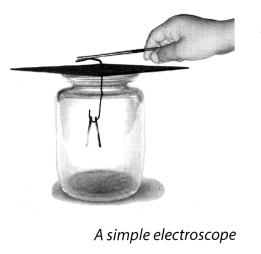
At the top, the metal rod enters in a metallic cup or disc. The bottom of the rod and the metal leaf are enclosed in a glass box for protection. When the disc of the electroscope is touched with a charged ebonite or glass rod, the metal leaves open out or diverge.
The extent of divergence depends upon the amount of charge on the electroscope. When the metal strips repel each other proves that the body is charged because repulsion is the sure test to detect that body is charged or not through an electroscope.
Question 10.
List three states in India where earthquakes are more likely to strike.
Answer:
Kashmir, Rajasthan and Gujarat.
Question 11.
Suppose you are outside your home and an earthquake strikes. What precaution would you take to protect yourself?
Answer:
We will take the following precautions to protect ourselves:
(i) Move to open space. Find a clean spot away from buildings, trees and overhead power lines. Drop to the ground.
(ii) If we are in a car or a bus, will not come out. Drive slowly to a clear spot and remain in it till the earthquake stops.
Question 12.
The weather department has predicted that a thunderstorm is likely to occur on a certain day. Suppose you have to go out on that day. Would you carry an umbrella? Explain.
Answer:
No, it is not advisable to carry an umbrella at all. Its metallic objects are more prone to lightning stroke. So an umbrella increases the risk.
Some Natural Phenomena Class 8 Science NCERT Intext Activities Solved
Activity 1 (NCERT Textbook, Page 185)
Jake a used ballpen refill and rub it vigorously with a piece of polythene. Bring it close to small pieces of paper. Take care not to touch the rubbed end of the refill with your hand or with a metallic object. Repeat the activity with small pieces of dry leaf, husk and mustard seeds. Record your observations.
Solution:
When we rub ballpen refill with polythene, it acquires a small electric charge. On bringing the charged ballpen refill close to small pieces of paper, the bits of paper are attracted to it. A charged plastic refill can attract bits of paper.
Activity 2. (NCERT Textbook, Page 185)
Collect the objects and the materials listed in Table 15.1. Try to charge each by rubbing with the materials mentioned in the Table. Record your findings. You can add more items to the Table.
Solution:

Through this activity, it can be concluded that certain objects acquire charge on being rubbed with certain materials. An object possessing charge will attract bits of paper.
Activity 3 (NCERT Textbook, Page 186)
(a) Inflate two balloons. Hang them in such a way that they do not touch each other (Fig. 15.1). Rub both the balloons with a woollen cloth and release them. What do you observe?
Now let us repeat this activity with the used pen refills. Rub one refill with polythene. Place it carefully in a glass tumbler using the tumbler as a stand (Fig. 15.2).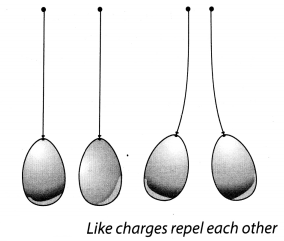
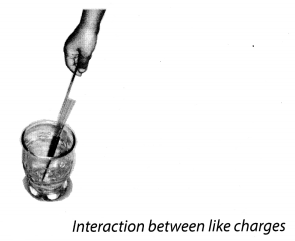
Rub the other refill also with polythene. Bring it close to the charged refill. Be careful not to touch the charged end with your hand. Is there any effect on the refill in the tumbler? Do the two attract each other, or repel each other?
In this activity we have brought close together the charged objects that were made of the same material. What happens if two charged objects made of different materials are brought close to each other? Let’s find out.
(b) Rub a refill and place it gently in a glass tumbler as before (Fig. 15.3). Bring an inflated charged balloon near the refill and observe.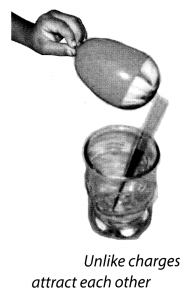
Solution:
(a) (i) We observed that balloons repelled each other in the first case. Thus, like charges repel each other.
(ii) In second case, a charged refill repelled another charged refill due to presence of like charges on them.
(b) A charged balloon attracted a charged refill because balloon had charges opposite to that on a refill. Thus, opposite charges attract each other.
Activity 4 (NCERT Textbook, Page 187)
Jake an empty jam bottle. Take a piece of cardboard slightly bigger in size than the mouth of the bottle. Pierce a hole in it so that a metal paper clip can be inserted. Open out the paper clip as shown in Fig. 15.4. Cut two strips of aluminium foil about 4 cm × 1 cm each. Hang them on the paper clip as shown. Insert the paper clip in the cardboard lid so that it is perpendicular to it (Fig. 15.4). Charge a refill and touch it with the end of the paper clip. Observe what happens. Is there any effect on the foil strips? Do they repel each other or attract each other? Now, touch other charged bodies with the end of the paper clip. Do foil strips behave in the same way in all cases? Can this apparatus be used to detect whether a body is charged or not? Can you explain why the foil strips repel each other?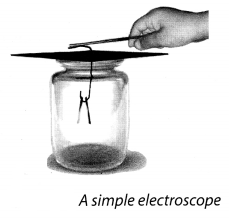
Solution:
We observed that aluminium foil strips received the same charge from the charged refill through the metal paper clip as it is good conductor of electricity. The strips carrying similar charges repelled each other and they became wide open. Such a device which can be used to test the charge on an object is called electroscope. When we touch the metal paper clip with other charged bodies, the foil strips behave in the same way in all cases. Thus, we find that electrical charges can be transferred from a charged object to another through a metal conductor.
Activity 5 (NCERT Textbook, Page 191)
Ask your parents about the huge damage to life and property caused by these earthquakes. Collect a few pictures showing the damage caused by these earthquakes from newspapers and magazines of those days. Prepare a short report on the suffering of the people during and after the earthquakes.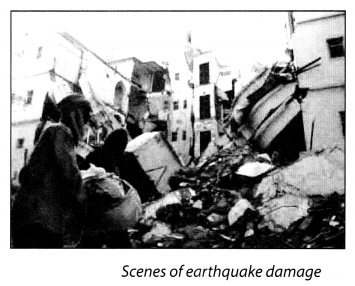
Report:
An earthquake is a sudden shaking or trembling of the earth which lasts for a short time. It is one of the most dreaded and devastating natural calamities. It causes a huge loss and destruction of our life and property. Some of the damaging effects of an earthquake are as follows:
- It brings destruction of buildings, dams, railway tracks, roads, etc.
- There is an outbreak of fire due to breaking of electrical power or gas lines.
- It ruptures groundwater pipe disrupting the water supply system.
- Landslides and tsunami occurs respectively in hilly and coastal areas.
- There is bursting of sewer pipes releasing sewage water.
- Communication is completely cut off and the areas gets 5 disconnected from the rest of the world.
- An earthquake also causes floods.
Activity 6 (NCERT Textbook, Page 192)
Take an outline map of the world. Locate the eastern coast and Andaman and Nicobar Islands in India. Mark other countries around the Indian Ocean which could have suffered damage. Collect accounts of the devastation caused by the tsunami in India from your parents, or other elders in the family or in the neighbourhood.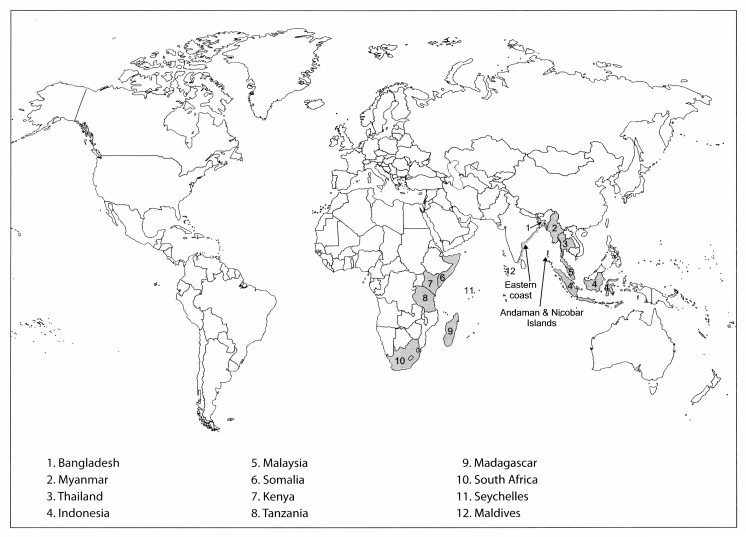
Solution:
(i) An outline map of the world locating the eastern coast and Andaman and the Nicobar Islands in India. Other countries around the Indian Ocean have been marked in the map given which could have suffered damage.
(ii) Accounts of the devastation caused by the tsunami in India—A major tsunami occurred in the Indian ocean on
26th December, 2004. At 8.38 a.m. quake of 6.1 magnitude was felt in Andamans. At 9.00 a.m. as it nears the Chennai coast, the tsunami slowed down but rose higher. This affected India’s South-East coast, predominantly in the state of Tamil Nadu as well as the territories of Andaman and Nicobar Island. Thousands of people died, and the coastal area devastated completely. Many fishing communities were ruined by the tsunami, most notably the fishing town of Nagapattinam. In fact, it was one of the most devastating natural calamaties, people have ever witnessed.
NCERT Solutions for Class 8 Science Chapter 15 – 1 Mark Questions and Answers
Question 1.
Why do two charge bodies attract or repel ? [NCT2008]
Answer:
When the two bodies have the same charges, they repel each other and when the two bodies have different charges they attract each other.
Question 2.
Write the one name of method by which object can be charged. [NCT2008]
Answer:
Object can be charged by conduction.
Question 3.
Which of the following cannot be charged easily by friction ? [NCERT]
- A plastic scale.
- A copper rod.
- An inflated balloon.
- A woollen cloth.
Answer:
A copper rod.
Question 4.
When a glass rod is rubbed with a piece of silk cloth the rod [NCERT]
- and the cloth both acquire positive charge.
- becomes positively charged while the cloth has a negative charge.
- and the cloth both acquire negative charge.
- becomes negatively charged while the cloth has a positive charge
Answer:
becomes positively charged while the cloth has a negative charge.
Question 5.
Tick T for true and F for false in the following statements : [NCERT]
- Like charges attract each other. (T/F)
- A charged glass rod attract a charged plastic straw. (T/F)
- Lightning conductor cannot protect a building from lightning. (T/F)
- Earthquakes can be predicated in advance. (T/F)
Answer:
- F
- T
- F
- F
Question 6.
Sometimes, a crackling sound is heard while taking off a sweater during winters. Explain. [NCERT]
Answer:
This crackling sound is heared because due to friction between the hair and sweater the sweater gets charged.
Question 7.
What is meant by earthing ?
Answer:
The process of transfer of charges from a charged object to the earth is called earthing.
Question 8.
When does a body become discharged ?
Answer:
When a body looses its charges, it is said to be discharged.
Question 9.
What is an earthquake ? [NCT 2011]
Answer:
An earthquake is a sudden shaking or trembling of the earth.
Question 10.
What causes an earthquake ?
Answer:
The tremors of the earthquake are caused by the disturbance deep down inside the uppermost layer of the earth called crust.
Question 11.
What are seismic waves ?
Answer:
The tremors produce waves on the surface of earth known as seismic waves.
Question 12.
Give the other name for weak zones.
Answer:
Seismic or fault zones.
Question 13.
Is the Electric Eel really electric ?
Answer:
Yes, the Electric Eel found in South America emits electric discharge.
Question 14.
How does the Electric Eel use the electric discharge ?
Answer:
Electric Eel uses electric discharges to give shock to its prey, discourage enemies and send signal to other Eels.
Question 15.
Name the scientist who first established the relationship between lightning and spark.
Answer:
In 1752, Benjamin Franklin, an American scientist, established that lightning and spark from amber were the same thing.
Question 16.
Why did it take 2000 years to establish the similarity between lightning and spark ?
Answer:
It took 2000 years because scientific discoveries are a result of hard work by many people.
Question 17.
What type of charge is present on the earth ?
Answer:
The earth has both positive and negative charges.
Question 18.
What is meant by a ‘discharged’ body ?
Answer:
The body from which the charge has been earthed loses the charge on it. Such a body is known as a ‘discharged’ body.
NCERT Solutions for Class 8 Science Chapter 15 – 2 Mark Questions and Answers
Question 1.
Explain why a charged body loses its charge if we touch it with our hand. [NCERT]
Answer:
When we touch a charged body with our hand, the body is earthed. This causes the charges flow to the earth and the body looses the charge.
Question 2.
List three states in India where earthquakes are more likely to strike. [NCERT]
Answer:
Three states in India where earthquakes can occur are Gujarat, Rajasthan and Jammu & Kashmir.
Question 3.
The weather department has predicted that a thunderstorm is likely to occur on a certain day. Suppose you have to go out on that day. Would you carry an umbrella ? Explain. [NCERT]
Answer:
No, I would not carry an umbrella. The charges produced during a thunderstrom can flow through the umbrella and harm us.
Question 4.
When a charged plastic straw is brought near a charged plastic straw, there is repulsion between them. What type of charge exists between them ?
Answer:
The charge on both the plastic straw are same, since like charges repel each other.
Question 5.
When a charged balloon is brought near a charged refill, there is attraction between the two. What type of charge exists between the two ?
Answer:
The charge on the balloon and a refill are different, because unlike charges attract each other.
Question 6.
Why is the charging by rubbing known as static electricity ?
Answer:
Charging by rubbing is known as static electricity because the charges do not move.
Question 7.
Give the difference between static electricity and electric current ?
Answer:
In static electricity, the charges do not move. In electric current, there is flow of charges.
Question 8.
When is lightning seen ?
Answer:
When the negative charges from the clouds and the positive charges on the ground meet huge amount of energy is produced as bright light and sound. This is seen as lightning.
Question 9.
Is the car safe during thunderstorm ?
Answer:
Yes, the car is safe during thunderstorm with windows and doors of the vehicle shut.
Question 10.
Can we use telephone during a thunderstorm ?
Answer:
No, it is not safe to use a telephone during thunderstorm, as lightning can strike through telephone cords.
Question 11.
Do the car tyres protect us from lightning ?
Answer:
No, the car tyres do not protect us from lightning, but the metal case of the car protects us.
Question 12.
Choose the correct option :
A charged plastic comb (B) is brought near another similar charged and suspended plastic comb (A). Then comb A
- remains unaffected
- moves towards comb B
- moves away from comb B
- starts oscillating
Answer:
moves away from comb B.
Question 13.
During lightning we have an electric discharge
- only between two opposite charged clouds
- only between a charged cloud and the ground
- either between two oppositely charged clouds or a charged cloud and ground.
- neither between two oppositely charged clouds nor between a charged cloud and ground.
Answer:
either between two oppositely charged clouds or a charged cloud and ground.
Question 14.
What is the effect of
- a charged object
- an uncharged object on small bits of paper ?
Answer:
- a charged object will attract bits of paper.
- an uncharged object will have no effect on bits of paper.
NCERT Solutions for Class 8 Science Chapter 15 – 3 Mark Questions and Answers
Question 1.
Name the scale on which the destructive energy of an earthquake is measured. An earthquake measures 3 on this scale. Would it be recorded by a seismograph ? Is it likely to cause much damage ? [NCERT]
Answer:
The destructive energy of the earthquake can be measured on the Richter scale. Yes, an earthquake measuring 3 would be recorded by the seismograph. This earthquake would not cause much damage.
Question 2.
Suggest three measures to protect ourselves from lightning. [NCT 2011, NCERT]
Answer:
We can protect ourselves from lightning by
- switching off and disconnecting all heavy electrical appliances.
- Not bathing under running tap water.
- Not standing near metallic poles.
Question 3.
Explain why a charged balloon is repelled by another charged balloon whereas an uncharged balloon is attracted by another charged balloon ? [NCERT]
Answer:
A charged balloon has the same charge as another charged balloon, so there is repulsion between them because like charges repel each other. On the other hand, an uncharged body always attracts a charged body. Therefore, an uncharged balloon is attracted by a charged balloon.
Question 4.
Apart from disturbance inside the earth, what are the other reasons of earthquake ?
Answer:
Earthquakes can also occur due to underground nuclear explosion, or when a volcano erupts, or when a meteor hits the earth.
Question 5.
What are weak zones ?
Answer:
Since earthquakes are caused by the movements of plates, the boundaries of the plates are weak zones where earthquakes are most likely to occur.
Question 6.
What useful changes are caused by earthquakes ?
Answer:
Earthquakes can also cause new islands, coral breaches and fresh water springs to emerge due to upheaval.
Question 7.
Name the weak zones in India ?
Answer:
The weak zones in India are Kashmir, Western and Central Himalayas, the whole of North¬East, Rann ofKutch, Rajasthan and the Indo-Gangetic Plane. Some areas of South India also fall in the danger zone.
Question 8.
Explain the working of seismograph.
Answer:
The seismograph consists of a vibrating rod which starts vibrating when tremors occur. A pen is attached to the vibrating rod that records the seismic waves on a paper which moves under it.
Question 9.
In highly seismic areas, which material should be used for construction of houses ?
Answer:
In highly seismic areas, the use of mud or timber is better than any heavy construction material. The roofs should be made as light as possible so that if the house falls, it does not cause much damage.
Question 10.
To make the house quake safe, what precautions should be taken ?
Answer:
To make the house quake safe, it is better if the cupboards and shelves are fixed to the walls, so that they donot fall easily. Clocks, photo-frames, water heaters should be hung carefully.
Question 11.
How are positive and negative charges produced during a thunderstorm ?
Answer:
Clouds are very small droplets of water in the form of vapour. A patch of cloud develops an electric charge on it by friction. The upper layers of cloud get positively charged and the lower layers of cloud get negatively charged.
Question 12.
How is electric discharge fatal for human beings ?
Answer:
The process of electric discharge can occur between two clouds, between clouds and the earth, even between the clouds and the human body. Such lightning strokes can be fatal.
Question 13.
A glass rod is rubbed against a silk cloth and an ebonite rod is rubbed against a piece of flannel. List the pairs which have
- similar
- dissimilar charges on them.
Answer:
- Glass rod and flannel (similar charge i.e., positive); Silk and ebonite (both negative)
- Glass rod and ebonite rod.
Question 14.
A charged drinking plastic straw is brought near another similar suspended straw that is
- also similarly charged ‘
- uncharged.
Explain what would happen in each case and why?
Answer:
- The suspended straw is repelled from it because of similar charge.
- The uncharged plastic straw is attracted towards it because the charged object applies a force on it.
Question 15.
Is it important to have a good contact between the lower end of lightning conductor and the earth ? If so, why ?
Answer:
It is important to have a good contact between the lower end of lightning conductor and earth so that the lightning charged flow deep down into the earth and not through the structure.
Question 16.
When and where major earthquakes have taken place in India ?
Answer:
On 26th January 2001 in Bhuj and on 8th October 2005 in Uri and Tangdhar major earthquakes had taken place.
Question 17.
A charged object is found to lose its charges when touched by hand. Explain why ?
Answer:
A charged object loses its charges when touched by hand because the charges flow to the earth through the human body. This is known as earthing.
Question 18.
Is lightning useful ? How ?
Answer:
Lightning is useful in many ways :
- Lightning is effective in the formation of ozone in nature.
- Lightning played an important role in the origin and evoluation of life on earth.
- Due to high discharge of electric charge through air nitrogen contributes with oxygen to form nitrate oxide and nitrogen dioxide gases.
Question 19.
What is Tsunami ? Explain.
Answer:
Tsunami is a Japanese name for tidal waves. They are large waves that are generated when the sea floor is deformed by seismic activity. A Tsunami can be 10 to 20 metres high when it hits the shore and a series of waves come at short intervals.
Question 20.
How will you make an electroscope if the gold leaf electroscope is not at hand ?
Answer:
Take a metallic bar on a stand. Take a strip of cellophane paper and fold it half. Hang it from the metallic bar. This will work like a gold leaf electroscope.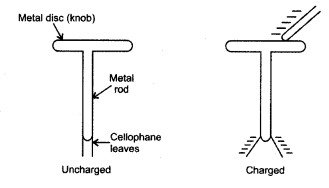
Question 21.
Why the gold leaves in an electroscope :
- diverge when touched charge glass rod.
- fold back when touched with hands.
- fold back when touched with a charged ebonite rod ?
Answer:
- Gold leaves diverge when touched with a charged glass rod because they both acquire similar charge.
- Gold leaves fold back when touched with hands because the charged is ‘earthed’.
- When touched with charged ebonite rod, the charges are neutralized, so the leaves fold back.
Question 22.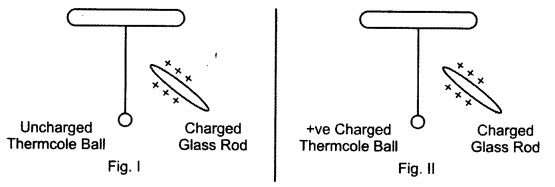
- What will you observe in Figure-I ?
- What will you observe in Figure-II ?
- What conclusion will you draw ?
Answer:
- In the figure-I the thermocole ball will be attracted to the glass rod.
- In the figure-II the thermocole ball will be repelled due to similar charge.
- The conclusion we draw is that attraction between two bodies is not a sure test of the presence of charge on a body. Repulsion is a sure that of charge on a body.
Question 23.
Is it true that a charged object always attracts an uncharged object but it may or may not attract another charged object ?
Answer:
Yes, an uncharged object is always attracted by a charged object. It will only attract another charged object, if the charge on it is opposite. If the charge on the other body is same, there will be repulsion.
NCERT Solutions for Class 8 Science Chapter 15 – 5 Mark Questions and Answers
Question 1.
Suppose you are outside your home and an earthquake strikes. What precaution would you take to protect yourself ? [NCERT]
Answer:
If you are outdoors and an earthquake strikes, we should some precautions take to protect ourself:
- Leave your building and more to open areas.
- Keep away from high rise buildings.
- Keep away from trees,, signboards, electric poles.
- If you are in a vehicle, remain inside it.
Question 2.
Describe with the help of a diagram an instrument which can be used to detect a charged body. [NCERT]
Answer: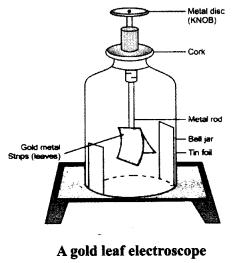
An electroscope is an apparatus to test an electric charge.
Conclusion: An electroscope has a brass rod passing through a tight fitting cork in a glass bottle. A pair of thin gold leaves are attached to the lower end of the brass rod. To protect the gold leaves from external electric charge the lower half of the bottle is lined with tin foil which is ‘earthed’ by connecting it to the table. This kind of electroscope is called a gold leaf electroscope.
Working: When a charged rod is touched to the metal disc, the charge is transferred to the gold leaves and they diverge.
Question 3.
What steps should be taken to protect yourself in case of an earthquake, if you are at home ?
Answer:
If you are at home :
- Do not stand near windows.
- Lie in bed.
- Do not stand near heavy objects that may fall on you.
- Stay under a table till the earthquake stops.
Question 4.
During a thunderstorm which places are safe ?
Answer:
During a thunderstorm, a house or building is the safest place. If you are travelling by car or by bus, you are safe inside with windows and doors of the vehicle shut.
Question 5.
During a thunderstorm, which places are unsafe if you are outside ?
Answer:
If you are outside :
- Open vehicles, like motor bike, tractor are not safe.
- Carrying umbrella is not a good idea.
- Stay away from poles or other metal objects.
- Do not lie on the ground.
Question 6.
If your friend is struck by lightning, how will you help him ?
Answer:
A lightning victim carries no electrical charge and cannot electrocute us. You can give first aid by performing mouth to mouth breathing.
Question 7.
Name the device used to secure tall buildings from lightning. Explain its construction and working.
Answer:
Lightning rod is a device used to secure tall buildings from the effect of lightning.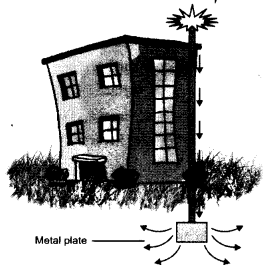
A metallic rod taller than the height of the building to be protected is installed in the walls of the building during its construction. One end of the rod is kept out in the air and the other is fixed in the ground. This provides easy route for transfer of electric discharge to the ground.
Question 8.
- Why do dry hair stand on when combed with a plastic comb ?
- What kind of charge is acquired by ebonite when rubbed with fur ?
- What kind of charge is acquired by fur when it is rubbed over ebonite ?
- What type of charge is borne on clouds facing the earth ?
- Is dry air a conductor or an insulator ?
Answer:
- Dry hair stand when combed with a plastic comb because they get charged.
- When rubbed with fur ebonite gets a negative charge.
- When fur is rubbe^ with ebonite, fur acquires positive charge.
- Normally, the layers of cloud facing the earth get negatively charged.
- Dry air is a bad conductor (or insulator) of electricity.
Question 9.
- Name the agency responsible for making quake proof houses ?
- What are seismic zones ?
- Give some suggestions how the houses should be made in seismic zones.
Answer:
- The technique to develop quake proof houses has been developed by Central Building Research Institute, Roorkee.
- The seismic zones are those areas which are prone to earthquakes. They are the areas lying on the boundaries of the plates.
- (i) The houses in seismic zones should be symmetrical.
(ii) The foundation of the building should be deep.
(iii) Roofs should be of light material and the fixtures should be light.
NCERT Solutions for Class 8 Science Chapter 15 – MCQs
Question 1.
Like charges when brought near each other then they
(a) repel
(b) attract
(c) sometimes attract and sometimes repel
(d) have no effect
Answer:
(a)
Question 2.
A device used to test the charge on an object is called
(a) ammeter
(b) electroscope
(c) seismograph
(d) none of these
Answer:
(b)
Question 3.
A major earthquake occurred on 8th October 2005 in
(a) Gujarat
(b) Delhi
(c) Haryana
(d) North Kashmir
Answer:
(d)
Question 4.
A sudden shaking of the earth lasting for a very short time is known as □
(a) lightning
(b) thunder
(c) earthquake
(d) Tsunami
Answer:
(c)
Question 5.
A major Tsunami occurred in the Indian Ocean on
(a) 26th December 2001
(b) 26th December 2002
(c) 26th December 2003
(d) 26th December 2004
Answer:
(d)
Question 6.
Instrument used to find the source of seismic waves is known as
(a) seismometer
(b) voltammeter
(c) galvanometer
(d) ammeter
Answer:
(a)
Question 7.
Richter scale is used to measure the magnitude of
(a) lightning
(b) charges
(c) earthquake
(d) rainfall
Answer:
(c)
NCERT Solutions For Class 8 Science
- Chapter 1 Crop Production and Management
- Chapter 2 Microorganisms: Friend and Foe
- Chapter 3 Synthetic Fibres and Plastics
- Chapter 4 Materials: Metals and Non-Metals
- Chapter 5 Coal and Petroleum
- Chapter 6 Combustion and Flame
- Chapter 7 Conservation of Plants and Animals
- Chapter 8 Cell Structure and Functions
- Chapter 9 Reproduction in Animals
- Chapter 10 Reaching the Age of Adolescence
- Chapter 11 Force and Pressure
- Chapter 12 Friction
- Chapter 13 Sound
- Chapter 14 Chemical Effects of Electric Current
- Chapter 15 Some Natural Phenomena
- Chapter 16 Light
- Chapter 17 Stars and the Solar System
- Chapter 18 Pollution of Air and Water
.png)
.png)